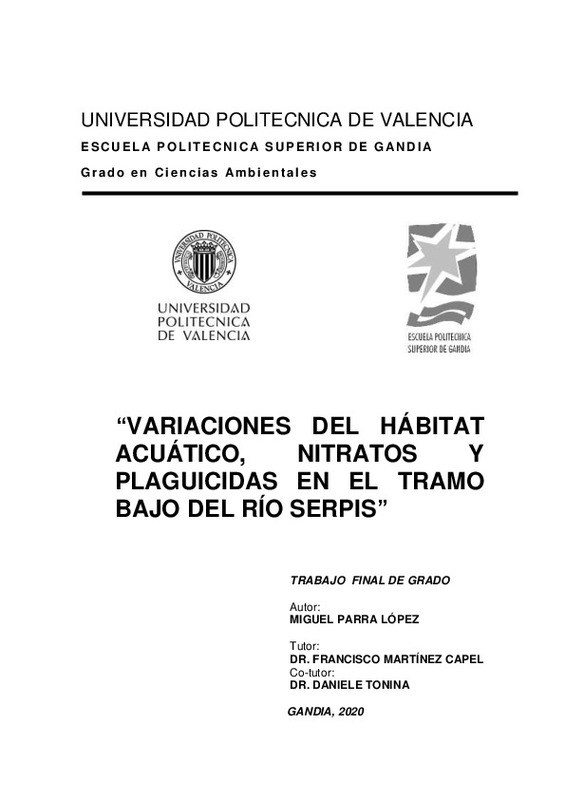|
Resumen:
|
[ES] El presente trabajo tiene como objetivo analizar las variaciones del hábitat desde el punto de vista físico y físico-químico en el tramo del río Serpis entre la salida del Barranco del Infierno (T.M. de Villalonga) y ...[+]
[ES] El presente trabajo tiene como objetivo analizar las variaciones del hábitat desde el punto de vista físico y físico-químico en el tramo del río Serpis entre la salida del Barranco del Infierno (T.M. de Villalonga) y el mar.
Este estudio pretende conocer como varían los distintos tipos de hábitats en un tramo de río con los cambios de época y caudal. Y puesto que la calidad química es también esencial para la vida acuática, se quiere conocer en que época del primer semestre (año 2020) se encuentran más nitratos en el agua, así como sus concentraciones máximas. Además, se estimará la concentración de plaguicidas, dado que es otro factor de contaminación esencial en zonas agrícolas, para estimar sus posibles efectos sobre las poblaciones de peces del río Serpis. Dado que este trabajo se desarrolla en el curso 2019-2020, durante el cual se ha decretado el estado de confinamiento de buena parte de los ciudadanos debido a la pandemia de COVID-19, durante más de un mes, el estudio se adaptará a las capacidades del alumno y tutor para la toma de datos, así como a la disponibilidad del laboratorio en el Campus de Gandía.
Para analizar el hábitat físico, se escogerá un tramo del río en el término municipal de Villalonga. Para varios meses distintos se clasificarán los hábitats acuáticos sobre ortofotos, para así poder analizar su variación a lo largo del periodo de estudio. Se cuenta ya con ortofotos que fueron obtenidas a partir de vuelos con dron en dicho tramo, en 2019.
Para analizar el hábitat desde el punto de vista físico-químico, se tomarán medidas y también muestras en varios puntos del tramo entre Villalonga y Gandia. Se harán sucesivas visitas para medir las variables básicas in situ: temperatura, conductividad eléctrica, oxígeno disuelto, turbidez y pH. También se tomarán muestras para estudiar la presencia de nitratos y pesticidas en las aguas de este río.
Partimos de la hipótesis inicial de que dichos contaminantes, nitratos y plaguicidas, procederían de los cultivos de cítricos que bordean los márgenes del rio Serpis, llegando al río por infiltración en el suelo o directamente al agua cuando se pulverizan.
[-]
[EN] The aim of this work is to analyse the variations of the habitat from the physical and physico-chemical point of view in the section of the Serpis River between the outlet of the Barranco del Infierno (Villalonga) and ...[+]
[EN] The aim of this work is to analyse the variations of the habitat from the physical and physico-chemical point of view in the section of the Serpis River between the outlet of the Barranco del Infierno (Villalonga) and the Mediterranean sea.
This study attempts to describe how the different types of habitats vary in a stretch of river with the changes of time and flow. Since the physico-chemical quality is also essential for the aquatic life, we want to know when the concentration of nitrates reaches the peak during the first semester of 2020, as well as its maximum concentration. In addition, the concentration of pesticides will be estimated, because they can mean another relevant pollution in agricultural areas, and we want to estimate its potential effects on fish populations in the Serpis River. Given that this work is carried out in the 2019-2020 academic year, when the state of confinement for citizens has been decreed due to the pandemic of COVID-19, the study will be adapted to the possibilities of the student and tutor for data collection, as well as the availability of the laboratory at the Campus of Gandía.
To analyse the physical habitat, a section of the river will be chosen in the municipality of Villalonga. For several different months, aquatic habitats will be classified on orthophotos, in order to analyse their variation throughout the study period. There are already orthophotos that were obtained from drone flights in the aforementioned river section, in 2019.
To analyse the habitat from the physico-chemical point of view, measurements and also samples will be taken at various points in the section between Villalonga and Gandia. In several visits I will measure the basic variables in situ: water temperature, electrical conductivity, dissolved oxygen, turbidity and pH. Samples will also be taken to study the presence of nitrates and pesticides in the waters.
We start from the initial hypothesis that some pollutants, nitrates and pesticides, would come from the citrus crops that border the banks of the Serpis River, reaching the running waters by infiltration into the soil or directly into the water when sprayed.
[-]
|




![PDF file [Pdf]](/themes/UPV/images/pdf.png)



